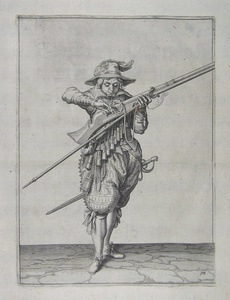| Method | Copper engraving |
| Artist | Jacob de Gheyn II |
| Published | [On les vend' ausi a Amsterdam chez Henry Laurens. 1608.] |
| Dimensions | Image 250 x 185 mm, Plate 255 x 190 mm |
| Notes |
Plate 10 from a set of 43 illustrations of firing positions of a musketeer, from the French edition of Jacob de Gheyn II's seminal military work De Wapenhandelinghe van Roers, Musketten ende Spiesen (1608). The musketeer, dressed in a characteristic wide-brimmed feathered hat, tunic, and slashed baggy trousers, raises his weapon towards his face, and blows on a lit taper in preparation for firing. With his right hand he primes the firing mechanism, and with his left, he supports the gun and holds the other end of the smoking taper. A powder horn, purse, and numerous shot cartridges hang from a bandolier across his chest, and a rapier hangs at his side. Jacob de Gheyn's De Wapenhandelinghe van Roers, Musketten ende Spiesen was widely regarded as the most militarily important illustrated manual of the early 17th century. Issued under the auspices of Maurice, Prince of Orange (1567 - 1625) during the Dutch rebellion against Spain, the book is an important record of military tactics and equipment during this time. Although it contained explanatory text, the work was chiefly valued for its 117 copper engravings, demonstrating in precise detail the stages and positions of fighting with arquebus, musket, and pike. The combination of pike and shot in a single unit was known as the tercio, and championed by the Spanish. The work was issued in a number of languages, including Dutch, German, and French, as well as being reprinted in English in 1631 as The Exercise of Armes. This text would play an important role in training officers for the English Civil War a decade later. Jacob de Gheyn II (c.1565 - 29th March 1629) was a Dutch painter and engraver, instrumental in the early Dutch Realism movement. Gheyn was among the first group of artists to paint the female nudes, vanitas paintings, and still lifes that would come to typify Dutch Realism. His first work as a military engraver was a commission from Maurice, Prince of Orange, to depict the Siege of Geertruidenberg. His most celebrated achievement was De Wapenhandelinghe van Roers, Musketten ende Spiesen, a military manual produced in a number of languages. Condition: Slight creasing and time toning to plate and sheet. Minor insect hole to centre of image, near the gunner's left hand. |
| Framing | unmounted |
| Price | £200.00 |
| Stock ID | 41175 |

